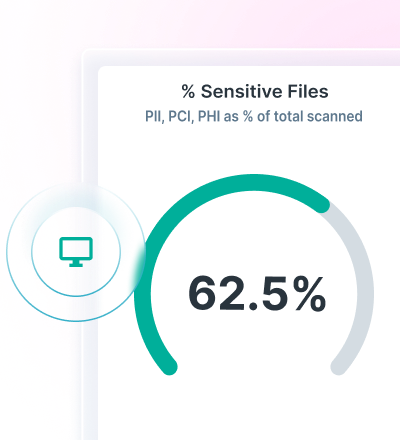Why DSPM Is the Missing Link for Data Security
0 min read

Tim Herr
There might be a blind spot in your data security program.
Security teams secure networks, apps, identities and endpoints, yet sensitive data continues to slip through the cracks. The reason is simple: you can’t protect what you can’t see.
That visibility is the missing link in most data security strategies, and it’s exactly the gap Data Security Posture Management (DSPM) is designed to fill.
Using DSPM, security teams can achieve continuous visibility into where sensitive data lives, how it’s being used and who has access, so they can reduce exposure and strengthen data security posture across cloud, SaaS and on-prem environments. In other words, DSPM closes the visibility gap that traditional tools leave behind.
If you’re investing in data protection but still worry about accidental exposure, insider risk or shadow data spreading into places it shouldn’t be, DSPM may be the link your data security program is missing.
The Data Security Blind Spot No One Talks About
Most organizations have strong security controls but still lack a complete understanding of their data. The problem isn’t technology. It’s visibility.
Data is created and duplicated constantly. It gets copied into SaaS apps, synced across personal devices, fed into AI tools or exported into spreadsheets to “work offline for a minute.” Before long, there are uncontrolled versions everywhere.
The result is a security gap:
- You don’t know where sensitive data actually resides
- You can’t confirm who has access, or if that access is appropriate
- You can’t quickly detect risky data exposure across cloud and SaaS
- You can’t govern or remediate what you can’t see
Traditional tools weren’t built to solve this. Data Loss Prevention (DLP) protects data in motion. Cloud Security Posture Management (CSPM) focuses on cloud infrastructure. Identity and Access Management (IAM) controls identities. None of them deliver full data-at-rest visibility across the modern data landscape.
But DSPM software changes that, delivering true insights into what data you have, where it’s located, who has access to it and what risks it poses.
How DSPM Strengthens Data Security Posture
At its core, DSPM data security gives you a complete and continuously updated map of your data so you can assess risk and act on it. It answers the questions organizations struggle with today:
- Where is our sensitive data stored?
- How is it classified?
- Who has access and is that access appropriate?
- What data is at risk right now?
A well-implemented DSPM solution includes four core capabilities:
1. Data Discovery Across All Environments
DSPM automatically scans cloud, SaaS and on-premises repositories to locate sensitive data, including “shadow data” that security didn’t know existed. This is essential for reducing blind spots and preventing silent sprawl.
2. AI-Powered Data Classification
Modern DSPM uses AI models to classify both structured and unstructured data with speed and context. This DSPM data security advantage is especially important as generative AI drives new data creation and reshaping. Accurate classification ensures that the most sensitive data is labeled and prioritized for protection and governance.
3. Risk Prioritization
Rather than just showing where data is, DSPM highlights where the risk is highest. It evaluates exposure, access permissions, sharing patterns and misconfigurations to reveal which data poses the greatest risk. Security teams can then focus their time where it matters most.
4. Remediation and Continuous Monitoring
Visibility alone isn’t enough. DSPM includes guided or automated remediation workflows to correct permissions, resolve policy violations, assign data ownership and clean up redundant or obsolete data. Continuous monitoring then keeps posture strong as data changes.
This full lifecycle is what transforms DSPM from a one-time audit or scan into an ongoing discipline.
DSPM Use Cases: Where the Gap Becomes a Problem
The value of DSPM shows up fast in real-world scenarios. Here are some high-impact DSPM data security use cases:
| Use case | The gap without DSPM | What DSPM enables |
|---|---|---|
| Securely Enable AI | Sensitive data can be exposed in AI tools or used to train models without guardrails | Classifies and restricts sensitive data from AI usage so teams can adopt AI safely |
| AI Data Classification | Legacy or manual methods miss context or can’t scale to new AI-generated data types | AI-powered classification with context, accuracy and automation across structured and unstructured data |
| Compliance Readiness | Hard to prove where sensitive data lives, who has access and whether controls are enforced | Continuous data visibility, reporting and remediation to prepare for audits with confidence |
| Data Access Governance | Over-permissioned users, shadow access and unclear data ownership create avoidable risk | Right-sizes access, assigns owners and enforces data access governance workflows |
Why DSPM Matters Now More Than Ever
With DSPM, data security fully extends to data-at-rest and eliminates data risk. There are three key reasons why that’s more critical for your strategy than it ever has been before:
1. Data Is Expanding Faster Than Security Can Keep Up
Multicloud environments, SaaS proliferation, remote work and AI-generated content all fuel data sprawl. The more data spreads, the harder it is to track and secure.
2. AI Makes Data More Dynamic and Risky
Generative AI has made data movement faster and less predictable. Employees paste sensitive data into AI tools, share training sets, or generate new data based on internal sources. Without controls that understand context, data can leak without anyone noticing.
This is where AI and DSPM intersect. DSPM provides the foundational inventory and classification needed to protect data in AI workflows. It helps organizations confidently enable AI without losing control of sensitive information.
3. Compliance and Regulations Are Tightening
Regulators expect organizations to prove they know where sensitive data lives and can enforce protective controls. DSPM strengthens compliance readiness by providing audit-ready visibility, reporting and governance across data stores.
Getting Started: A Practical Path to DSPM Data Security Success
To get value fast, treat DSPM as a security capability that builds over time, not a massive year-long project. Here’s a practical approach:
- Start with a data risk baseline. Identify your highest-value and highest-risk data domains.
- Run a pilot in one environment. Cloud file storage or a major SaaS repository is ideal.
- Validate classification accuracy. Confirm that AI labeling aligns with your business priorities.
- Assign data owners. This is the piece most security teams skip. Accountability powers sustainability.
- Create a remediation workflow. Decide how over-permissioned or exposed data will be fixed.
- Expand and automate. Scale to more data sources and automate as confidence grows.
If your organization already has DLP or CASB controls, DSPM amplifies their impact by feeding them better context and visibility.
The Bottom Line: DSPM Is the Link That Makes Data Security Whole
You can invest in the best DLP, identity, cloud security and compliance tools, but if you don’t have full visibility into your data, you’re still exposed. DSPM completes the data security picture. It uncovers blind spots, strengthens governance and gives security teams confidence that their most valuable data is protected wherever it lives or moves.
If you want to eliminate data blind spots and gain real control of your data exposure, now is the time to evaluate DSPM. See how Forcepoint DSPM can give you full visibility and control over your data estate.

Tim Herr
Read more articles by Tim HerrTim serves as Brand Marketing Copywriter, executing the company's content strategy across a variety of formats and helping to communicate the benefits of Forcepoint solutions in clear, accessible language.
 Gartner®: Market Guide for Data Security Posture ManagementView the Report
Gartner®: Market Guide for Data Security Posture ManagementView the Report
X-Labs
Get insight, analysis & news straight to your inbox

To the Point
Cybersecurity
A Podcast covering latest trends and topics in the world of cybersecurity
Listen Now









